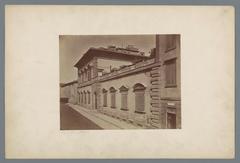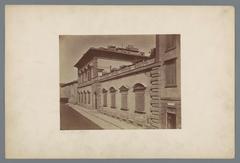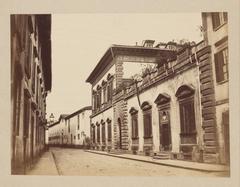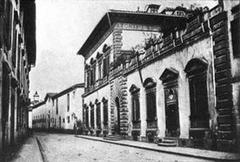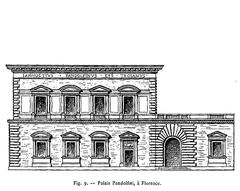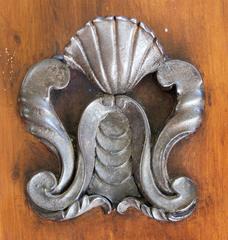
Palazzo Pandolfini Florence: Visiting Hours, Tickets, and Historical Sites Guide
Date: 15/06/2025
Introduction
Palazzo Pandolfini is an exceptional example of Renaissance architecture that stands as a testament to Florence’s cultural, artistic, and aristocratic heritage. Situated on Via San Gallo, in the northern part of Florence’s historic center, this palace was commissioned in the early 1500s by Giannozzo Pandolfini—bishop, humanist, and confidant of the Medici popes Leo X and Clement VII. Designed by Raphael and constructed under the supervision of the Sangallo brothers, Palazzo Pandolfini displays a sophisticated blend of classical style, humanist ideals, and aristocratic ambition. While still a private residence, the palace occasionally opens its doors for special cultural events and guided tours, allowing a privileged glimpse into the refined world of Renaissance Florence.
This guide provides comprehensive information on Palazzo Pandolfini’s history, architectural highlights, visiting hours, ticketing, accessibility, travel tips, and nearby attractions. Whether you are a history enthusiast, architecture aficionado, or simply seeking unique experiences in Florence, Palazzo Pandolfini offers a rewarding detour from the city’s well-trodden tourist paths.
For the most current visitor information, see Florence RockinArt – Palazzo Pandolfini, Girovagate Guided Tours, and the Pandolfini Foundation.
Contents
- Introduction
- Origins and Historical Context
- Architectural Significance
- Design and Construction
- Architectural Features
- Notable Events and Family Legacy
- The Pandolfini Family
- Artistic and Cultural Connections
- Visiting Palazzo Pandolfini: Hours, Tickets, and Tours
- Visiting Hours
- Tickets and Booking
- Accessibility
- Photography and Conduct
- Special Events and Private Tours
- Travel Tips and Nearby Attractions
- Frequently Asked Questions (FAQ)
- Conclusion
Origins and Historical Context
Palazzo Pandolfini was begun in 1516, at a time when the northern edge of Florence was still characterized by fields and religious institutions. The land originally belonged to the friars of Montesenario and was near the Monastery of San Silvestro (Florence RockinArt). Giannozzo Pandolfini, Bishop of Troia, commissioned the palace as a reflection of his family’s prestige and connections to the Medici popes. The Pandolfinis were counted among the city’s elite from the 13th century and contributed significantly to Florence’s civic and cultural life (Firenze Made in Tuscany).
Architectural Significance
Design and Construction
The palace’s design is attributed to Raphael, making it a unique example of his architectural work in Florence. Giorgio Vasari documented this attribution, and construction began around 1516, with local execution by Giovanni Francesco da Sangallo and, later, his brother Bastiano (“Aristotile”) da Sangallo (The History of Art). The building process, which extended until 1532, was marked by interruptions and was completed after the deaths of both Giannozzo Pandolfini and Giovanni Francesco da Sangallo (Florence RockinArt).
Architectural Features
Palazzo Pandolfini’s façade is celebrated for its symmetry, rusticated stonework, refined window frames, and a monumental cornice inscribed in honor of Popes Leo X and Clement VII. The harmonious proportions, classical elements, and the integration of the Church of San Silvestro as a private chapel exemplify the era’s blending of religious and residential spaces. The palace’s gardens, initially designed by Raphael, featured fountains, statues, and exotic plants, a gift from Leo X (Girovagate).
Notable Events and Family Legacy
The Pandolfini Family
The Pandolfinis have played an enduring role in Florence, producing magistrates, priors, and gonfaloniers. The palace has remained in the family since its construction—a rare continuity in Florentine history. In the 19th century, Count Alessio Pandolfini and his wife Sofronia Stibbert, sister of Frederick Stibbert (of Stibbert Museum fame), undertook major restorations, including the transformation of the gardens into a romantic English-style park (Firenze Made in Tuscany).
Artistic and Cultural Connections
Raphael’s involvement, both in the architectural and garden design, reflects the Pandolfini family’s artistic ambitions. The palace hosted intellectuals, artists, and dignitaries, strengthening its reputation as a Renaissance cultural hub. The Stibbert connection linked Palazzo Pandolfini to one of Florence’s most eclectic museums (Firenze Made in Tuscany).
Visiting Palazzo Pandolfini: Hours, Tickets, and Tours
Visiting Hours
Palazzo Pandolfini remains a private residence and does not have regular opening hours. Public access is limited to special events, heritage days, and pre-arranged guided tours, which usually take place on select weekends or during cultural festivals. Always consult official resources or local tour providers for up-to-date schedules.
Tickets and Booking
- Ticket Prices: Guided tours typically cost between €15 and €25, depending on the tour provider and event.
- Booking: Advance reservation is mandatory due to limited access. Book through local associations, event platforms, or official tour operators (Girovagate; Florence RockinArt).
Accessibility
Historic features such as stairs and uneven floors may limit access for visitors with mobility challenges. Contact organizers in advance to discuss specific needs or accommodations.
Photography and Conduct
Photography inside the palace is generally restricted. Exterior and garden photography is often permitted during public openings, but always confirm with staff. Visitors are expected to respect the private nature of the residence and follow all guidelines.
Special Events and Private Tours
The palace occasionally hosts cultural events, exhibitions, and private receptions, offering rare access to additional rooms or gardens. Watch Florence’s cultural calendars and the Pandolfini Foundation for announcements.
Travel Tips and Nearby Attractions
- Best Time to Visit: Spring and early autumn coincide with more frequent cultural events and comfortable weather.
- Location: Via San Gallo 74, within a 10-minute walk of the Duomo and other central landmarks. Easily reached on foot or by public bus.
- Nearby Attractions:
- Stibbert Museum: Extensive arms and armor collection, linked to the Pandolfini family (Firenze Made in Tuscany).
- Badia Fiorentina: A historic abbey, also tied to the Pandolfini legacy.
- Galleria dell’Accademia, Piazza San Marco, Mercato Centrale: All within 10 minutes’ walk.
- Dining: Numerous cafes and restaurants can be found on Via San Gallo and surrounding streets.
Frequently Asked Questions (FAQ)
Q: Can I visit Palazzo Pandolfini at any time?
A: No, the palace is only open for special events or guided tours, which require advance booking.
Q: How do I book a visit?
A: Reservations can be made via cultural associations, event organizers, or official city tourism platforms. Check the Pandolfini Foundation and Florence’s event calendars.
Q: Is the palazzo accessible for wheelchair users?
A: Accessibility is limited due to historic architecture. Contact organizers before booking for specific inquiries.
Q: Are photographs allowed?
A: Photography is often permitted outdoors during events, but generally not inside. Confirm with your guide at the start of your visit.
Q: What else is there to see nearby?
A: The Stibbert Museum, Badia Fiorentina, Galleria dell’Accademia, and Florence’s main cathedral are all within walking distance.
Conclusion
Palazzo Pandolfini offers visitors an exclusive window into Renaissance Florence—its architecture, artistic networks, and the enduring legacy of a noble family. Though access is limited, planning ahead for guided tours or cultural events ensures an enriching experience. Combine your visit with nearby museums and historical landmarks for a comprehensive understanding of Florence’s multifaceted heritage.
Stay informed about opening opportunities and cultural programming through the Florence RockinArt, Pandolfini Foundation, and Visit Florence.
For curated travel tips and updates, download the Audiala app and follow Florence’s cultural channels.
Sources and Further Reading
- Florence RockinArt – Palazzo Pandolfini
- Girovagate – Guided Tours
- Firenze Made in Tuscany
- The History of Art: Raphael’s Palazzo Pandolfini
- Visit Florence – Events Calendar
- Pandolfini Foundation
- UNESCO World Heritage: Florence
- Firenze Patrimonio Mondiale
- Artsupp: Villa Carducci Pandolfini
